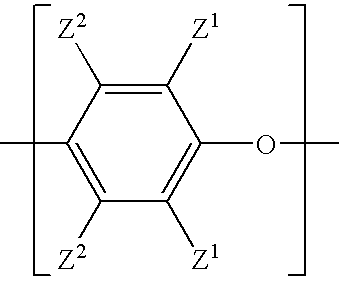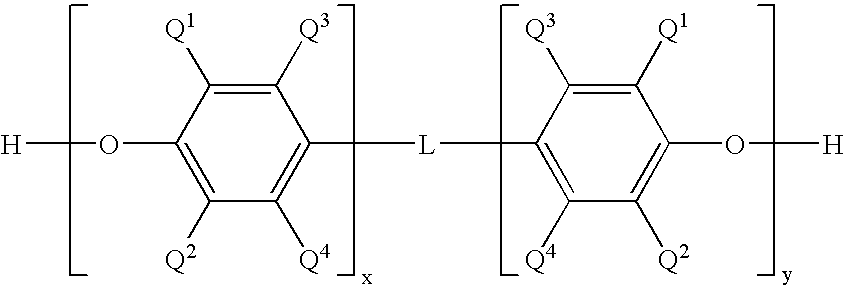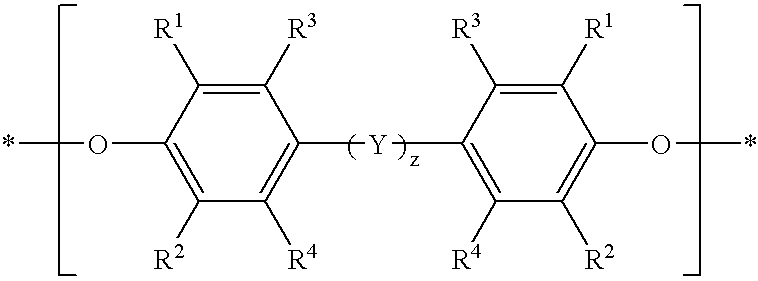Poly(arylene ether) preparation method
a poly(arylene ether) and preparation method technology, applied in chemical/physical/physical-chemical stationary reactors, chemical apparatus and processes, chemical/physical/physical-chemical processes, etc., can solve problems such as anti-solvent handling and disposal problems, and poor yields of capped poly(arylene ether) precipitation
- Summary
- Abstract
- Description
- Claims
- Application Information
AI Technical Summary
Problems solved by technology
Method used
Image
Examples
example 1
PREPARATIVE EXAMPLE 1
[0046]This example describes a general procedure for preparing a solution of a bifunctional poly(arylene ether). A bifunctional copolymer of 2,6-dimethylphenol (2,6-xylenol; 2,6-X) and 2,2-bis(3,5-dimethyl-4-hydroxyphenyl)propane (tetramethylbisphenol A; TMBPA) was prepared by oxidative copolymerization in toluene in the presence of a copper amine catalyst. The monomer mixture consisted of 83 weight percent 2,6-dimethylphenol and 17 weight percent 2,2-bis(3,5-dimethyl-4-hydroxyphenyl)propane. The catalyst copper and other water soluble components were either allowed to remain in the reaction mixture or extracted with an aqueous trisodium nitrilotriacetate (NTA) solution. The resulting bifunctional poly(arylene ether) (PPE) resin had an intrinsic viscosity (IV) of about 0.09 deciliter per gram (dL / g), measured in chloroform at 25° C. The terminal hydroxy groups of the bifunctional PPE were methacrylate-capped by reaction with methacrylic anhydride (MAA; 1.1 moles...
examples 1-5
[0053]Examples 1-5 illustrate the effect the concentration of the solids in the organic phase and the concentration of the aqueous base have on the retention of water in the organic phase during the extraction process.
[0054]After capping the bifunctional poly(arylene ether), the resulting toluene solution (44.4% solids) was purified as follows: a 10 gram aliquot of the solution was diluted to the required weight percent solids by adding toluene and the diluted solution was put in an oil bath at 80° C. for 30 minutes. The required amount of deionized water and 50 weight percent NaOH solution were added to obtain the desired NaOH weight percent in the aqueous phase; the typical addition was approximately 1 weight part of aqueous solution per 7 parts of toluene solution. Right after addition of the aqueous phase, the mixture was shaken by hand for one minute, and then the mixture was put back in the oil bath at 80° C. for 30 minutes. After this time, the mixture was taken out of the oi...
examples 7-10
[0059]These examples illustrate the effects of aqueous phase composition (water versus aqueous NaOH) and organic phase solids concentration on residual water and capping reagents and byproducts, as well as the quality of phase separation. The extraction procedure of Examples 1-5 was used. The quality of the separation of the organic phase and aqueous phase was determined visually and is reported as “Decanted well”, or “Organic phase emulsified” when an emulsion is formed. The concentration of MAOH+MAA, and that of DMAP were determined on a dry polymer basis (indicated by *). The results are listed in Table 4 below.
[0060]It can be seen from Table 4 that extraction with water removes essentially all the DMAP, the retention of water in the organic phase is relatively low, and the separated phases are easily decanted. However, the concentration of the residual MAA+MAOH is relatively high. On the other hand, extracting with aqueous sodium hydroxide is more effective in removing MAA and M...
PUM
| Property | Measurement | Unit |
|---|---|---|
| Temperature | aaaaa | aaaaa |
| Percent by mass | aaaaa | aaaaa |
| Percent by mass | aaaaa | aaaaa |
Abstract
Description
Claims
Application Information
 Login to View More
Login to View More - R&D
- Intellectual Property
- Life Sciences
- Materials
- Tech Scout
- Unparalleled Data Quality
- Higher Quality Content
- 60% Fewer Hallucinations
Browse by: Latest US Patents, China's latest patents, Technical Efficacy Thesaurus, Application Domain, Technology Topic, Popular Technical Reports.
© 2025 PatSnap. All rights reserved.Legal|Privacy policy|Modern Slavery Act Transparency Statement|Sitemap|About US| Contact US: help@patsnap.com



